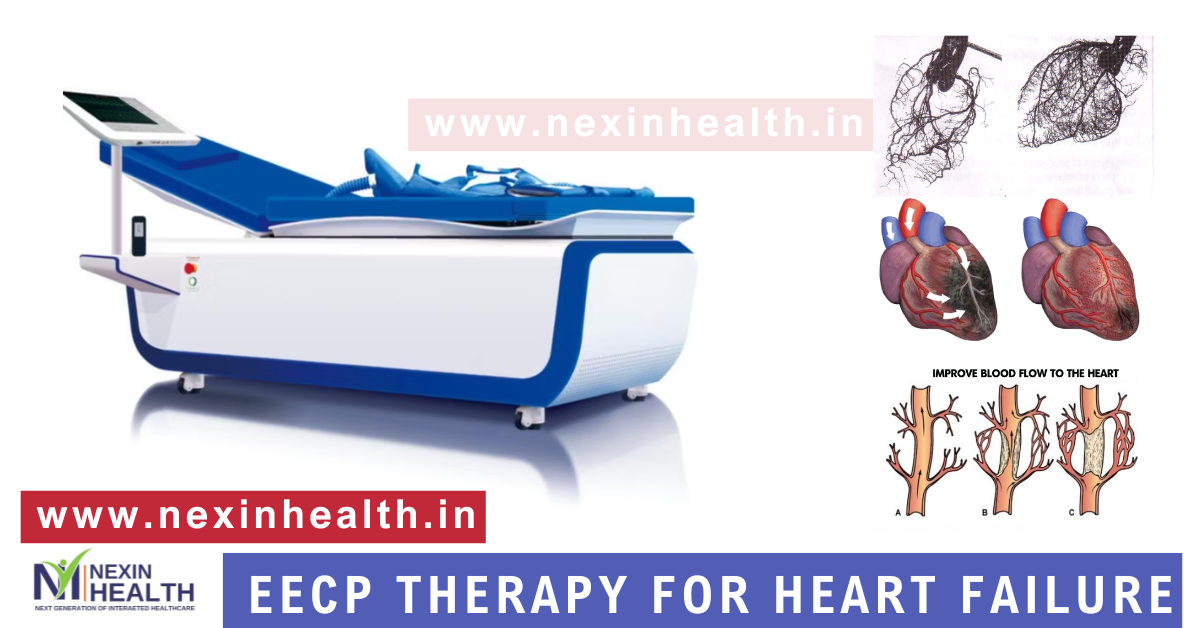EECP Therapy for Congestive Heart Failure


EECP Therapy for Congestive Heart Failure: Heart failure is a condition that affects millions of people worldwide. It occurs when the heart cannot pump blood efficiently enough to meet the body’s needs. Patients often experience fatigue, shortness of breath, and swelling in the legs, which significantly affects their quality of life. Fortunately, Enhanced External Counterpulsation (EECP) therapy offers a non-invasive treatment option for improving heart function and relieving symptoms of heart failure.
EECP therapy is a non-surgical treatment designed to improve blood flow and enhance heart function. It involves the use of inflatable cuffs placed around the legs and buttocks. These cuffs inflate and deflate in sync with the patient’s heartbeat, pushing blood toward the heart during the resting phase (diastole). This process improves oxygen delivery to the heart muscle and encourages the formation of new blood vessels, a process known as collateral vessel development.
In heart failure, the heart’s ability to pump blood efficiently is compromised. This is often measured by the ejection fraction (EF), which is the percentage of blood pumped out of the left ventricle with each beat. A normal left ventricular ejection fraction (LVEF) ranges from 55% to 70%. In patients with congestive heart failure (CHF) or cardiomyopathy, the LVEF is significantly reduced, meaning the heart is not functioning at full capacity.
EECP therapy addresses key issues in heart failure by improving blood circulation and reducing the heart’s workload. Here’s how it helps:
EECP therapy promotes the development of collateral blood vessels, which can bypass blocked or damaged arteries. This creates a “natural bypass” around the damaged areas, improving overall blood flow to the heart. Additionally, EECP reduces the heart’s workload by assisting blood flow, reducing the strain on the heart, and improving left ventricular function.
By synchronizing the inflation and deflation of the cuffs with the heart’s rhythm, EECP enhances the filling of the coronary arteries during diastole (the heart’s resting phase). This increases oxygen-rich blood supply to the myocardium (heart muscle) and helps alleviate the symptoms of heart failure.
EECP therapy is suitable for patients who have:
EECP therapy typically involves 35 one-hour sessions over seven weeks. During each session, the patient lies on a bed while cuffs wrapped around the legs and buttocks inflate and deflate in sync with the heart’s rhythm. The entire process is painless, and most patients experience a sense of relaxation. This therapy works to push more blood back to the heart, improving its function and relieving symptoms.
While EECP therapy is generally safe, certain patients may not be eligible for the treatment. Contraindications include:
The endothelium is the thin layer of cells lining the blood vessels, playing a crucial role in vascular health. In patients with heart failure, endothelial dysfunction can worsen the condition. EECP therapy stimulates the release of nitric oxide, a molecule that helps relax and dilate blood vessels. This improves blood flow, reduces vascular resistance, and protects the endothelium, contributing to better heart function over time.
Patients with heart failure often face the prospect of invasive procedures such as angioplasty or bypass surgery. EECP offers a safer alternative for those who are not ideal candidates for surgery due to their condition. EECP therapy reduces heart load without the risks associated with invasive treatments, such as infections, blood clots, or complications from general anesthesia.
Each session lasts for about an hour, and most patients undergo 35 sessions. The long-term benefits can be felt for up to two years, making it an effective strategy for managing heart failure.
EECP therapy has received widespread approval from various healthcare authorities, including the FDA in the U.S. Research and clinical trials conducted across the globe have demonstrated its effectiveness in treating heart failure and improving patients’ quality of life. Ongoing studies continue to explore the full potential of EECP therapy for various cardiovascular conditions.
EECP therapy offers heart failure patients a non-invasive, natural way to boost heart health, reduce symptoms, and improve quality of life. By increasing blood flow, improving endothelial function, and reducing vascular resistance, EECP helps the heart pump more efficiently, offering a viable alternative to invasive procedures.
If you or a loved one is suffering from heart failure, consider EECP therapy as a safe and effective option to help manage the condition and improve heart health. Consult with your healthcare provider to determine if this therapy is right for you.